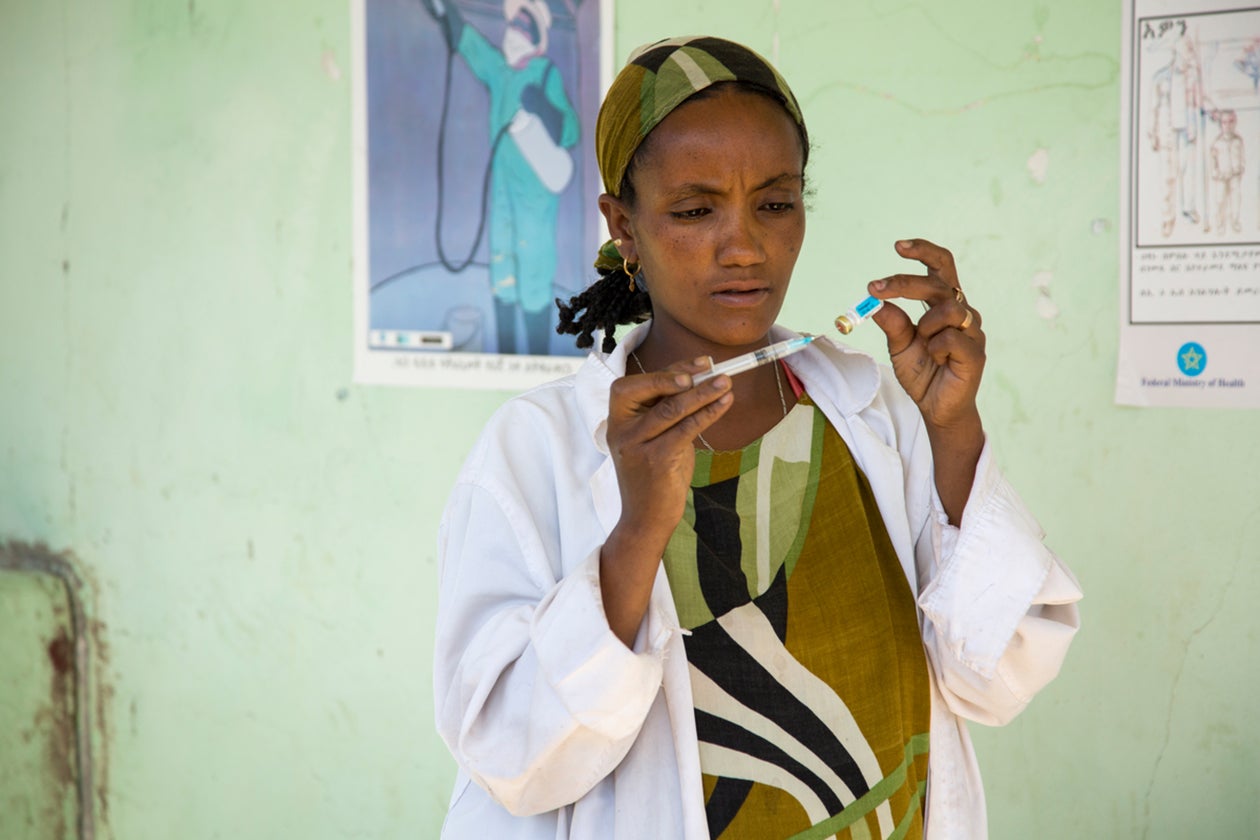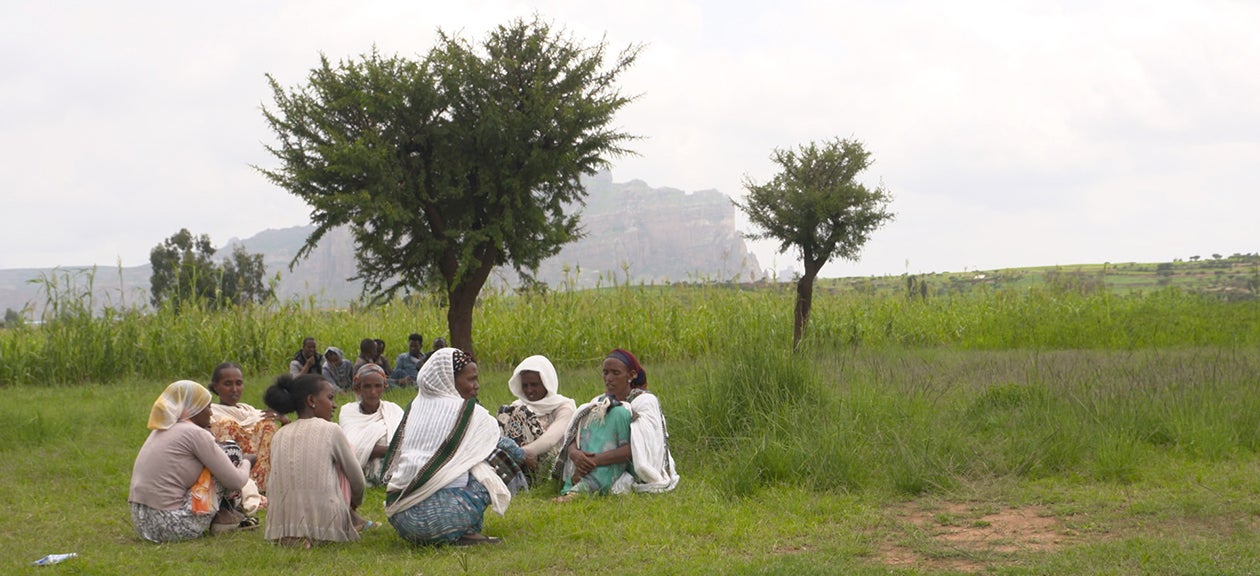Key Points
Low productivity and poor quality of care continue to plague the Health Extension Program, reducing equity in access to quality health care.
The overburdening of existing health workers is a concern, as populations grow and health-seeking behaviors take root.
The government has resolved to address these and other concerns by increasing the number of health workers, increasing support structures, and improving health worker training.
Starting from an extremely low baseline, Ethiopia has dramatically improved access to care. But there remains significant room for improvement. For example, DTP3 rates have increased from 30 percent in 2000, to 73 percent in 2016. However, the percentage of children who have completed the full package of childhood immunizations, while having improved almost threefold (from 14 percent in 2000, to 39 percent in 2016), shows most children still do not receive their total eight immunizations.
Even after a half-century of programming, a four-year pilot, research visits to community health worker programs around the world, and a problem-centered, evidence-based approach, the Health Extension Program experienced and continues to experience challenges that undermine optimal performance and impact.
Early Challenges
Generating Demand
When the Health Extension Program was first launched, there were initial challenges in generating demand for services. Because the Health Extension Workers (HEWs) did not provide curative services, there were communities in which their services were not understood or valued. It took time before communities recognized the knowledge the Health Extension Workers possessed was in and of itself valuable, and could help keep families and communities healthy.
Supply Chain
In the early days of the program, irregular supply and appropriate storage of vaccines, and irregular availability and/or lack of other medicine was a serious constraint. A majority of HEWs feel that between 20 to 50 percent of their professional inputs were not utilized because of these and other technical constraints. A 2013 Population Council survey of health centers and health posts in the Amhara region of Ethiopia found that “surveyed HPs had inadequate access to key equipment required for clean and safe delivery: many HPs lacked torches, examination couches, resuscitation devices, syringes, and suturing material necessary for obstetric procedures.” To address these supply chain issues, Ethiopia implemented a new Integrated Pharmaceutical Logistic System (IPLS) under the leadership of the Pharmaceutical Fund and Supplies Agency (PFSA). Under this system, facilities make bimonthly requests for supplies, and regional warehouses manage delivery.

Implementation Challenges
Low HEW Job Satisfaction
Independent evaluations of the Health Extension Program in 2007 and 2010 revealed HEWs were overburdened, particularly as populations boomed, and demand for healthcare increased. While HEW responsibilities grew, many HEWs had served for years without a salary increase, and with no clear path to advancement.
After having invested significantly in the development and establishment of this workforce, the government acted swiftly to ensure its program didn’t falter. First, it created the Health Development Army to take on some of the HEWs' lower-level tasks.
With long-term sustainability and staff retention in mind, the government went one step further in 2012 and introduced a career ladder for HEWs, providing them a pathway that leads as far as becoming a physician. The government also introduced a new ranking within the Health Extension Program, the Level IV HEW or a community health nurse. To advance from level III to IV, HEWs must complete another year of full-time training in a technical vocational school, culminating in the receipt of a community health nursing diploma. This is not the equivalent of becoming a nurse, although it does increase the HEWs' clinical capacity, equip them to provide communities with more sophisticated curative services, and increase their pay.
An important barrier to this approach is that HEWs often have only a tenth-grade education (and in some instances, even less than that), so career advancement will likely require significant additional education and training.
Remaining Challenges
Low Quality of Care
Concerns about quality of care have been with the program since its launch. Although the government has implemented an improved training course, quality concerns have not yet been fully allayed.
One study that demonstrated this challenge looked at HEWs in 490 health posts across the Jimma and West Hararghe zones of the Oromia region. The study found that after participating in a six-day training to strengthen their capacity to assess, classify and treat childhood pneumonia, diarrhea, malaria, malnutrition, and measles, HEWs provided correct case management for 64 percent of the children in their care. However, that percentage went down for children with severe illness, with only 34 percent of them having been correctly managed.
Productivity
Compounding low-quality care are concerns about productivity. A study of how HEWs spend their time found that rural HEWs spend about one-quarter of their day waiting for patients and only 13 percent of it providing health education or services. Their other time is spent on community engagement, travel, record keeping, supply chain administration, and other activities.
Time spent on different activities by HEWs
FMOH, HEPCAPS II Project. 2015. Health Extension Workers Time Motion Study Complemented by In-depth Interviews within Primary Health Care Units in Ethiopia. Addis Ababa, Ethiopia, Boston, Massachusetts, and New Haven, Connecticut: Ethiopian Federal Ministry of Health, Harvard T.H. Chan School of Public Health, Yale Global Health Leadership Institute, JSI Research & Training Institute, Inc.
Inequity
As a consequence of these performance issues, access to quality health care in Ethiopia continues to be highly inequitable. Women in the lowest wealth quintile are less than one third as likely to give birth in a facility than women in the highest wealth quintile. And children in highest wealth quintile are three times more likely to receive the full complement of vaccinations than children in the lowest wealth quintile. But there are some areas in which equity is improving, such as child mortality and family planning.
Under-five mortality rate and health indicators by wealth quintile
Ineffectiveness in Pastoralist and Urban Settings
Key participants interviewed reported that the Health Extension Program has not, as of yet, been fully adapted and implemented in pastoralist and urban settings.
Significant adjustments in the program will be necessary to achieve the same impact and scale. For example, in pastoralist settings, where about ten percent of the population lives, there are simply not enough women with a tenth-grade education to fill the positions needed. Thus far, the government has adapted by reducing the required education level to eighth-grade. But as there were still not enough women to fill the two HEW positions in each village, the government began allowing men to serve as HEWs in such communities. Government officials, in partnership with international NGOs, continue to experiment with different models specifically tailored to pastoralist and urban regions to ensure the program translates to these communities.
In poor urban areas, the government is rolling out programming based on the Family Health Team model. In these areas, a team, comprised of community health workers, clinicians, public health professionals, environmental technicians, social workers, and others, provides community and household level health services. The model is based on community health worker programming in urban .
Plans for the Future
There is now broad recognition that the Health Extension Program needs some adjustments in order to continue improving health across the country. The government's recent internal evaluation recognized the need to adapt the program to reflect Ethiopia's economic growth and changing health burdens, and the broader concerns expressed by informants, that the HEP is suffering from "complacency."
“The HEP is not a fixed, static thing. There should be a certain dynamism. It solved the problems during the initial period, but now, we need a second generation HEP. We need a career structure. Are we still thinking of scale-up the same way? We need to respond to the changes that are happening."
Key informant
A second-generation Health Extension Program, now being developed, will include the following adjustments:
- Upgrading 35,000 HEWs from Level III to Level IV
- Increasing the number of HEWs from two to three
- Renovating the health posts, including equipment and supplies
- Shifting preventive services to the HDA
- Institutionalizing the HDA network of women’s groups and other community groups
- Redesigning the HEP for pastoralist settings
- Strengthening the urban HEP
- Incorporating two new HEP service packages: non-communicable diseases and mental health
In 2018, the MOH submitted the Second-Generation HEP proposal to the prime minister and parliament.

